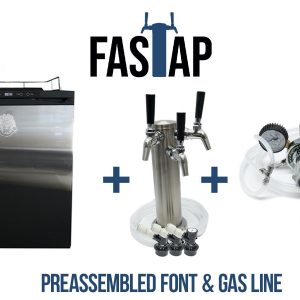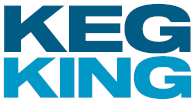
This page can help you to set up and better understand how to operate a kegerator.
Before you get started, it’s important to know some basic information and terminology for how keg systems operate.
GLOSSARY:
Ball lock Disconnects - There are two types, Gas and Liquid. Disconnects are used for connecting the gas line to the keg and also attach the liquid line from the keg to the shank. If constructed of plastic, Grey disconnects are for gas and black disconnects are for liquid. If constructed from stainless steel, the gas disconnect will include a white collar and the liquid disconnect will include a black collar for identification.
Coupler- device that attaches onto commercial sized (50L) kegs for feeding gas into a keg and dispensing liquid from the keg. The coupler type must match the keg variety. A-type for A-type Kegs, D-type for D-type kegs, S-type for S-type kegs.
Font- the tower on top of a kegerator or bar top that houses the beverage taps
Gas Cylinder – Sometimes referred to as a gas bottle, contains carbon dioxide gas under pressure for serving draft beverages
Gas lines – any tubing used to connect the gas cylinder to the kegged beverages
Kegerator – a fridge converted to serve draft beer or beverages.
Liquid lines – any tubing used to connect the kegged beverage to the tap
Low Profile Elbow Bend – an additional piece of equipment to reduce height on couplers so that they’ll fit on top of kegs in kegerators with low ceiling headspace
Posts – the connection points for the gas and liquid disconnects on a ball lock variety keg
Pressure Relief Valve (PRV) – found on ball lock keg lids and some coupler varieties. The PRV is designed to reduce pressure should the keg be taken up beyond a safe working pressures.
MFL – Male Flare Fitting
Push Fittings – a small connector device used to connect tubing to couplers, disconnects and brewery equipment by pushing the tube into the fitting
Regulator – attaches to the gas cylinder to control the flow of carbon dioxide gas pressure to the keg
Shanks- the hardware that attaches to the font that will connect the tap to the beverage lines.
Stepless Clamps – a small clamping device used to hold tubing fast onto barbed connections
Tap – The faucet that serves the liquid enjoyment!
When you receive your Keg King Kegerator, depending on the variety of kegerator package you have purchased, there will be some assembly required. To assist you, we have step by step video guides to demonstrate the assembly of our kegerators. In most cases, there is a QR code on the fridge box that will open the video when scanned. If you can’t find a QR code, you can simply find the video on the product webpage or by going to our YouTube channel here: https://www.youtube.com/channel/UCCjG5f5hk28SLVA9f5PN2Qw?view_as=subscriber
KEG BASICS
Beer served from kegs is the ultimate way to enjoy your beverage. Kegged beer remains fresh if it is served from a proper dispensing system like our kegerators or bar service systems. Carbon Dioxide, not air, is used to pressurise the keg and keep the beverage from spoiling. How long will a keg of beer last?
Well, that is based on how fast you drink it, but it will stay fresh and carbonated until you have poured the last glass.
The beer or beverage inside the keg is dispensed by pressurising the headspace in the keg. This helps keep the beverage carbonated so your cold keg inside the kegerator stays sparkling every pour.
The majority of kegs draw liquid from the bottom up a tube called the spear inside commercial kegs or in the case of ball lock variety kegs the liquid is drawn up the diptube. The principal remains the same whether using commercial or ball lock kegs, the headspace is pressurised by the C02 cylinder and the liquid is drawn out of the keg and into the tap.
TEMPERATURE AND PRESSURE
While keg beer is simple to dispense, there are a few elements that need to be balanced before your beverage will pour perfectly. Temperature and pressure are crucial to have correct before you serve or there is a risk of over carbonating the beverage.
Simply put, the colder the liquid, the more gas it can absorb. The easiest way to serve from our kegerators if you have purchased commercial kegged beer is to apply the coupler and set your gas regulator to between 10psi and 12psi. Our kegerators are short draw systems that don’t require excessive back pressure. If you are serving your own beer that is not yet carbonated, the fool proof way to carbonate properly is to refer to this chart here SET AND FORGET CHART LINK.
The proper temperature for your beer is somewhere between -2C and 2C. This is up to you and how you enjoy your beverage. You will need to adjust your regulator pressure to achieve the proper pour without over carbonating the keg.
LINE LENGTH
Your kegerator will be packaged with beverage and gas lines. The gas line is just for getting the CO2 into the kegs and can be adjusted in length if needed required. Your liquid line should not be adjusted in length. Our kegerator systems are normally packaged with 5mm ID 8mm OD beverage line. For each keg, users will need at least 3.5 metres of 5mm ID line to create enough resistance for the beer to pour properly out of the tap. If you cut your liquid lines short, the beer will leap from the keg to the tap and pour foam. A meter of line excess is not going to cause an issue.
If you are cutting your own lines to go to the tap, here are some recommended lengths to assist you in getting a good pour:
1.5 meters if using 4mmID x 8mmOD line
3.5 to 5 meters if using 5mmID x 8mmOD line
7 to 8.5 meters if using 6mmID x 8mmOD line
COUPLERS, DISCONNECTS & ADAPTORS
If you are serving commercial kegs you will need to find out what type of keg the brewery packages their beverages. In Australia, the majority of kegs are either A-type, D-type or S-type. Each keg variety requires a specific coupler to attach to the keg.
Popular A-type Keg Brands In Australia Include: Balmain Brewing, Bridge Road, Brookvale, Bundy and Cola, Canadian Club, Carlsberg, Coopers, Franzikaner, Furphy, Guiness, Hahn Super Dry, Heineken, Hills Cider, James Boags, James Squire, Kilkenny, Kirin, Kosciuszko, Kronenbourg, Little Creatures, Lowenbrau, Magners Cider, Paulaner, Pipsqueak Cider, Sample, Sapporo, Spaten, Tooheys, Two Birds, White Rabbit, XXXX Gold, Young Henrys
Popular D-Type (Sanke) Keg Brands in Australia Include: VB, Carlton Draught, 2 Brothers, 4 Pines, Bulmers Cider, Cascade, Cricketers Arms, Crown Lager, Fat Yak, Great Northern, Kingfisher, Konig, Monteith’s, Mountain Goat, Peroni, Pure Blonde, Reschs Draught, Somersby, Tiger Beer
Disconnects: Disconnects are required if you are using Ball Lock kegs. Each Ball Lock Keg will require one Grey Gas Disconnect and one Black Liquid Disconnect. Disconnects come in plastic and in stainless steel varieties. You can choose from MFL or Barbed variety disconnects. The MFL variety includes a thread for attaching a swivel nut and barb and the Barbed variety simply includes a 6mm barb for attaching to the liquid or gas line. To hold the line fast onto the 6mm barb, we suggest using 9.5mm stepless clamps because they provide a nice tight grip around the outside of the 8mm outer diameter of our beverage and gas lines. 
FOAMY BEER?
If you’ve reviewed all of the set up and operating procedures for your kegerator but your tap is pouring foam, check out the ‘HELP MY TAP’S POURING FOAM!’ page in our Resources Section.
Questions on Beer Styles, How to Brew, Ingredients and more are all available on our resource pages: https://www.kegking.com.au/blog/
